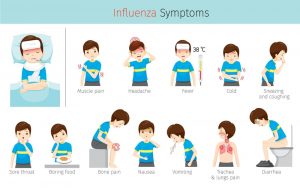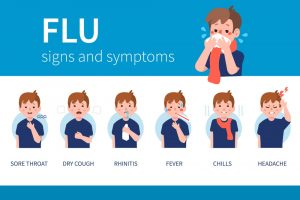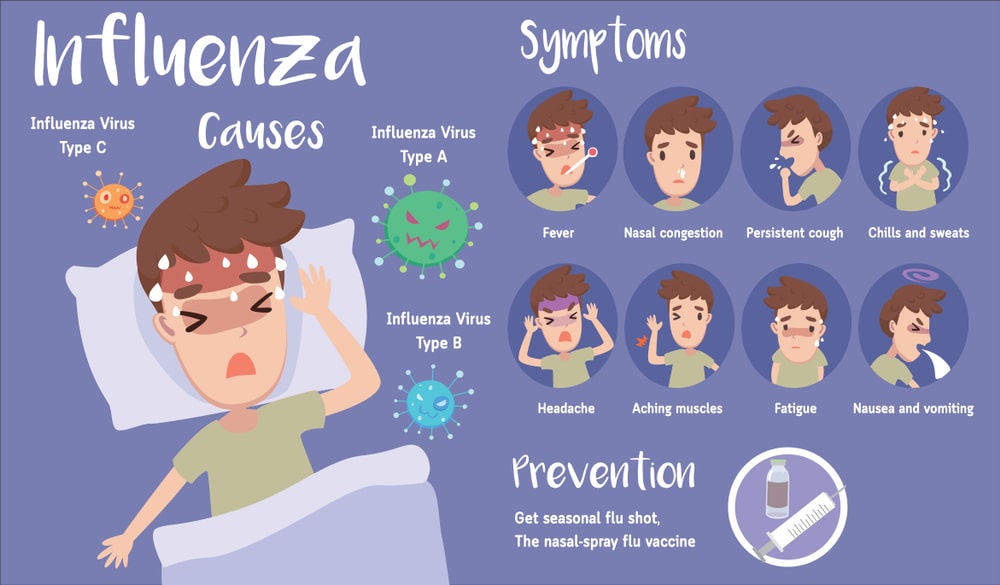Understanding the Different Types of Influenza
Flu is also known as ‘influenza’. It is a contagious respiratory disease that is caused by influenza viruses. Flu viruses get in the body through the mucus membranes of the nose, mouth, or eyes. Let’s learn more on different types of Influenza. You infect yourself with a virus whenever you touch your hand in one of these areas.
Normally the flu season starts in October and ends in May every year. In the 2017-2018 flu season, around 53 kids have died in the United States. Older people, pregnant women, children, and those with long-term illnesses are at a higher risk of getting flu complications.
How Flu and Influenza are different?

Influenza or flu is different from the common cold. Both have a contagious viral infection of the respiratory tract and have similar symptoms. However, the flu is much worse and can make it difficult for you to get out of your bed.
Influenza (flu) and the common cold are both contagious respiratory illnesses, but they are caused by different viruses. Flu is caused by influenza viruses only, whereas the common cold can be caused by a number of different viruses, including rhinoviruses, parainfluenza, and seasonal coronaviruses.
Seasonal coronaviruses should not be confused with SARS-CoV-2, the virus that causes COVID-19. Because flu and the common cold have similar symptoms, it can be difficult to tell the difference between them based on symptoms alone.

Flu Symptoms include – cough, runny nose, sore throat, body pain, chills, high fever, watery eyes, headache, weakness, and fatigue. These symptoms often come on abruptly. Many people take the flu vaccine to avoid this illness and its severe complications.
However, sometimes even those who have taken their shots suffer from flu. Hence it is very important to take preventive measures during the flu season. Flu is highly contagious and can spread from person to person by coughing, sneezing, or touching surfaces. Let’s learn more on different types of Influenza.
Types Of Influenza:

There are three types of Influenza(flu) viruses which are; Type A, Type B, and Type C. Type A and B cause yearly influenza epidemics that result in around 20% of the population having high fever, coughing, aching, and sniffling. Although type C also causes flu, its symptoms are not very severe.
Type A: These types of Influenza can infect animals; however, more commonly people suffer the ailments related to this type of flu. Generally, wild birds act as the hosts of this flu virus. Type-A flu viruses are usually responsible for large flu epidemics.
Type B: These types of Influenza virus is found solely in human beings. This flu may sometimes be less severe than Type A flu, but it can still be extremely detrimental. Type B flu viruses generally do not cause epidemics.
Type C: These types of Influenza viruses normally cause mild respiratory symptoms or no symptoms at all. This type does not cause epidemics and also does not have a serious impact on influenza types A and B. Although there is a flu vaccine for types A and B, there is no such immunization for type C flu virus.
How is Flu Treated?

Antibiotics do not help in flu treatment. Your doctor may prescribe antiviral medicines such as Oseltamivir (Tamiflu) and Zanamivir (Relenza) to treat flu. Additionally, painkillers may help in alleviating headaches and body aches.
To treat flu, Oseltamivir or Inhaled Zanamivir are usually prescribed for five days, while one dose of intravenous peramivir or one dose of oral Baloxavir are usually prescribed. Oseltamivir treatment is given to hospitalized patients, and some patients might be treated for more than five days.
Besides this, a person affected by flu should rest at home, keep warm, possibly avoid contact with people, drink lots of liquids and avoid smoking and drinking. Consult a doctor at once in case the temperature remains high after 4-5 days or if the symptoms worsen or one feels shortness of breath. Hope, you have understood about different types of Influenza.
Read Also:
https://www.offshorecheapmeds.com/blog/flu-medication-influenza/

